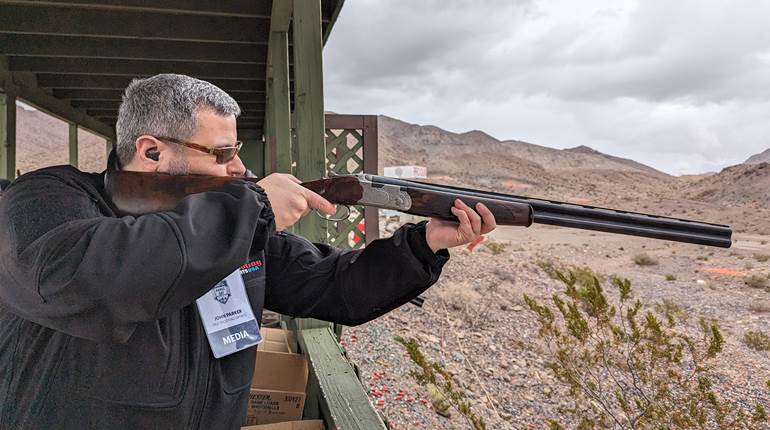
Since its introduction in 1886, the L.C. Smith Hammerless has held the distinction of being the only side-by-side sidelock shotgun made in America, garnering legions of fans that encompass both shooters and collectors.
The L.C. Smith legacy began in 1884, four years after Lyman Cornelius Smith became the sole proprietor of W.H. Baker & Co., manufacturer of a three-barreled drilling consisting of two side-by-side smoothbores over a rifled barrel—a firearm style that was not overly popular in America. Undeterred, the entrepreneurial Smith turned to the inventive talents of his employee, Alexander T. Brown (who went on to develop the Dunlop tire and other automotive inventions). Brown designed an exposed-hammer sidelock double, dubbed the “L.C. Smith Hammer Gun,” which incorporated a sturdy “double cross-locking” rotary bolt and a strengthened barrel hinge. Introduced in 1884, this new L.C. Smith enjoyed considerable success.
 Smith decided to apply those same attributes to a hammerless sidelock, but he improved upon the concept, creating a simpler, stronger action, a more graceful receiver and escalating exterior embellishments that were priced accordingly. But while his shotgun attracted well-heeled hunters, it failed to hold Smith’s attention; he became enthralled with developing a new-fangled “type writing” device. Thus, in 1888, Smith sold his company to Fulton, N.Y., railroad builder John Hunter, Sr., who established the Hunter Arms Co. to manufacture L.C. Smith shotguns, while Smith went on to create the Smith-Corona typewriter.
Smith decided to apply those same attributes to a hammerless sidelock, but he improved upon the concept, creating a simpler, stronger action, a more graceful receiver and escalating exterior embellishments that were priced accordingly. But while his shotgun attracted well-heeled hunters, it failed to hold Smith’s attention; he became enthralled with developing a new-fangled “type writing” device. Thus, in 1888, Smith sold his company to Fulton, N.Y., railroad builder John Hunter, Sr., who established the Hunter Arms Co. to manufacture L.C. Smith shotguns, while Smith went on to create the Smith-Corona typewriter.
It was under the Hunter Arms banner, which flew from 1889 until 1945, that some of America’s finest shotguns were built. Yet, from the basic blued and casehardened “workhorse” varieties to elaborately engraved showpieces, the interior mechanisms of every gun retained the same degree of meticulous excellence. Unfortunately, financial woes and family mismanagement forced the company into bankruptcy in 1917. It was subsequently acquired in 1920 by a group of Fulton’s citizens, along with the Simonds Saw And Steel family of Fitchburg, Mass.
Internal problems persisted, however, and, in 1945, the company again filed for bankruptcy before being acquired by Marlin Firearms, which kept America’s sidelock alive until 1949, when a floor in the old Fulton factory collapsed. After producing 57,929 guns under Marlin’s stewardship, by 1950, L.C. Smith was out of business. In 1968, Marlin attempted to resurrect the shotgun as limited-production Field and Deluxe versions made in its New Haven, Conn., factory, but producing a labor-intensive sidelock amid competition from imports doomed the venture. After a scant 2,539 Marlin-made L.C. Smiths were manufactured, production was halted in 1971.
Today, the Hunter Arms shotguns—known colloquially as “Elsies”—made until 1945 have the greatest value, although Marlin-made L.C. Smiths are also of interest. Early L.C. Smiths were graded by “qualities” until 1896, then from 1896 to 1913, by “grades,” which utilized a combination of numbers and letters (“Monogram” and “Pigeon” were exceptions), with 00 being a basic gun and A3 denoting the highest quality. After 1913, the grading system changed to reflect names such as Field, Ideal, Specialty, etc. For escalating grades and prices, customers got progressively better qualities of Damascus and, later, fluid-steel barrels, more elaborate engraving and more finely figured, hand-checkered wood.
This 12-ga. No. 3E L.C. Smith, which was catalogued from 1892 until 1912, was priced at $100 when introduced—a substantial sum considering the average worker made $16 a week back then. This particular gun was made in 1902. Stocked in English walnut with Nitro steel barrels, the pristine bores are choked full and full, and each lockplate is hand-engraved with a pair of upland birds inside an oval panel. A total of 3,042 No. 3 guns were made, of which 2,592 were 12 gauge, and 2,432 had automatic ejectors. Today, this shotgun is worth from $4,250 to $4,500.
Gun: L.C. Smith No. 3E (denotes ejector)
Gauge: 12
Serial No.: 81XX
Manufactured: April 14, 1902
Condition: NRA Excellent (Modern Gun Standards)
Value: $4,250 to $4,500





































